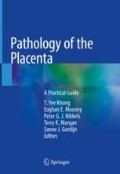Abstract
An appropriate placenta triage system has to balance evidence-based indications for examination with clinical demand and available resources. In case of unfavourable outcome, there is also a legal aspect of the placental examination that cannot always be anticipated at the time of triage. Clinical demand is assessed in partnership with obstetricians and neonatologists. Triage systems can give general direction but each case should be judged individually. This chapter gives practical recommendations based on the recent Royal College of Pathologists (RCPath) and older College of American Pathologists (CAP) guidelines of which placentas need to be examined. In general, the RCPath guideline include full examination of fewer placentas than the CAP guideline. The following examination categories are considered: (1) full gross and microscopic examination of the placenta; (2) full gross examination, samples embedded, but histology only reported on clinical demand; and (3) gross examination with no sections embedded for histology, with short-term placental storage, reporting only if further clinical demand emerges. We describe 16 groups of placenta submissions and categorize them as to what type of examination may be considered: stillbirth (antepartum or intrapartum); early, late or recurrent miscarriages; termination of pregnancy; unexpected admission to neonatal intensive care unit; severe fetal distress; prematurity; fetal growth restriction; hydrops; amniotic fluid infection; abruption; morbidly adherent placenta; gestational diabetes; maternal comorbidities; abnormally shaped placenta; macroscopically noted umbilical cord abnormalities; and twin placentas.
Guidance for examination of placentas from live born babies is complex. Local consensus between the clinicians and pathologists should be established for practice. The system we present in this chapter describes a practical example of how placental examination can work in a routine histopathology laboratory, with a conservative approach to resource utilization, in keeping with the more recent RCPath guideline. Local practices will need to be created and adhered to, based on a locally adapted guideline taking into account the department’s capacity, ensuring that all those placentas that require examination are examined.
Access this chapter
Tax calculation will be finalised at checkout
Purchases are for personal use only
References
Ptacek I, Sebire NJ, Man JA, Brownbill P, Heazell AE. Systematic review of placental pathology reported in association with stillbirth. Placenta. 2014;35:552–62.
Cox P, Evans C. Tissue pathway for histopathological examination of the placenta. London: Royal College of Pathologists; 2017.
Hargitai B, Marton T, Cox PM. Best practice no 178. Examination of the human placenta. J Clin Pathol. 2004;57:785–92.
Langston C, Kaplan C, Macpherson T, Manci E, Peevy K, Clark B, et al. Practice guideline for examination of the placenta: developed by the Placental Pathology Practice Guideline Development Task Force of the College of American Pathologists. Arch Pathol Lab Med. 1997;121:449–76.
Roberts DJ. Perinatal pathology: practice suggestions for limited-resource settings. Arch Pathol Lab Med. 2013;137:775–81.
Odibo I, Gehlot A, Ounpraseuth ST, Magann EF. Pathologic examination of the placenta and its clinical utility: a survey of obstetrics and gynecology providers. J Matern Fetal Neonatal Med. 2016;29:197–201.
Paul M, Goodman S, Felix J, Lewis R, Hawkins M, Drey E. Early molar pregnancy: experience in a large abortion service. Contraception. 2010;81:150–6.
Salafia CM, Vintzileos AM. Why all placentas should be examined by a pathologist in 1990. Am J Obstet Gynecol. 1990;163:1282–93.
Kraus FT. Perinatal pathology, the placenta, and litigation. Hum Pathol. 2003;34:517–21. discussion 522–7.
Author information
Authors and Affiliations
Corresponding author
Editor information
Editors and Affiliations
Rights and permissions
Copyright information
© 2019 Springer Nature Switzerland AG
About this chapter
Cite this chapter
Hargitai, B., Marton, T., Heerema-McKenney, A. (2019). Indications for Examining the Placenta. In: Khong, T., Mooney, E., Nikkels, P., Morgan, T., Gordijn, S. (eds) Pathology of the Placenta. Springer, Cham. https://doi.org/10.1007/978-3-319-97214-5_3
Download citation
DOI: https://doi.org/10.1007/978-3-319-97214-5_3
Published:
Publisher Name: Springer, Cham
Print ISBN: 978-3-319-97213-8
Online ISBN: 978-3-319-97214-5
eBook Packages: MedicineMedicine (R0)

